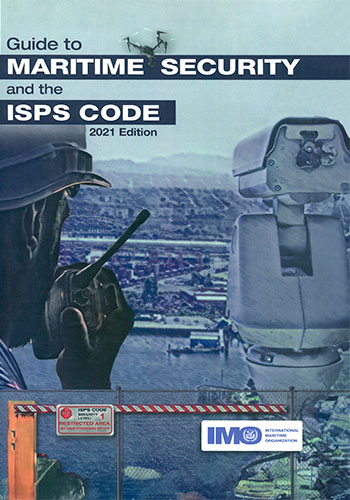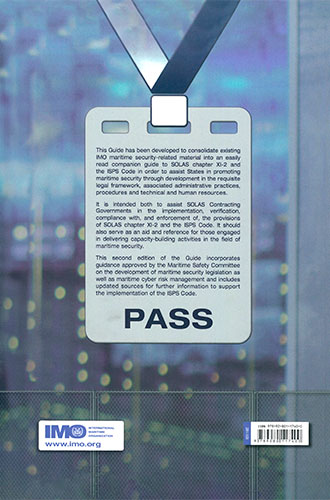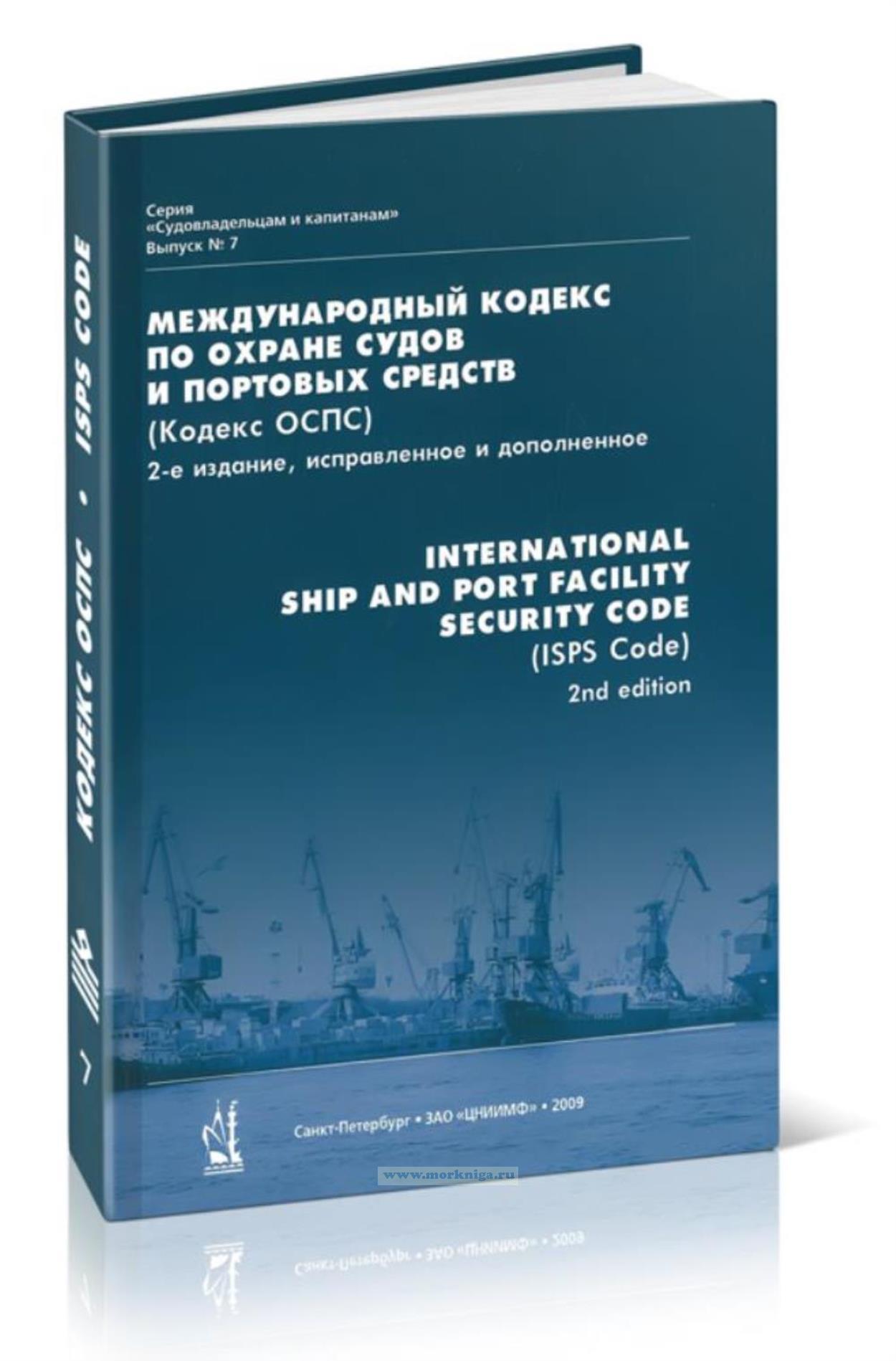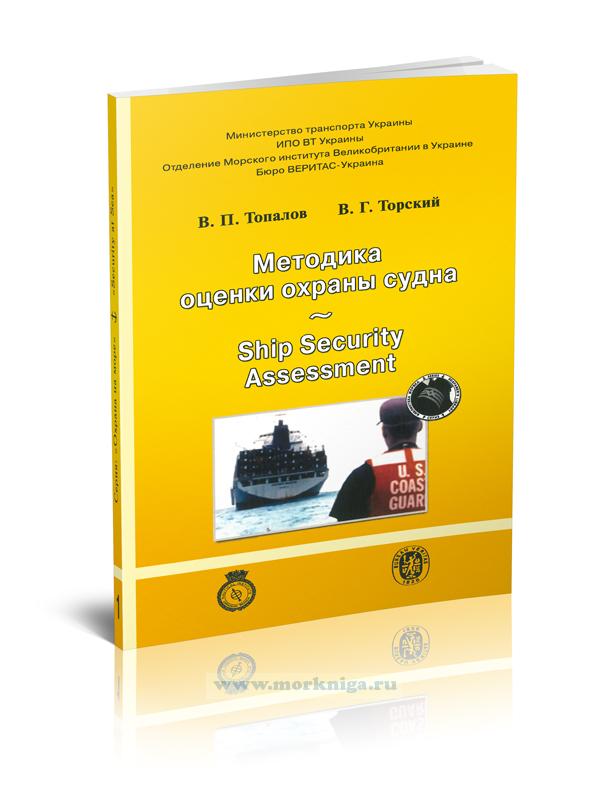Сб с 10 до 16
Guide to maritime security and the ISPS Code. Справочник по международному кодексу по охране судов и портовых средств (кодексу ОСПС)
Книга на английском языке
This Guide has been developed to consolidate existing IMO maritime security-related material into an easily read companion guide to SOLAS chapter XI-2 and the International Ship and Port Facility Security (ISPS) Code in order to assist States in promoting maritime security through development of the requisite legal framework, the associated administrative practices and procedures, and the necessary material, and technical and human resources. It is intended both to assist SOLAS Contracting Governments in the implementation of, verification of, compliance with and enforcement of the provisions of SOLAS chapter XI-2 and the ISPS Code, and to serve as an aid and reference for those engaged in delivering capacity-building activities in the field of maritime security.
Contents
Guide to maritime security and the ISPS Code
Foreword
Section 1 – Introduction
1.1 Purpose of the Guide
1.2 Structure
1.3 Sources
1.4 Overview of the Maritime Security Measures
Origins
The SOLAS Convention
The SOLAS amendments 2002
Conference resolutions
The Maritime Security Measures in brief
Milestones
1.5 Benefits of, and challenges in, implementing the Maritime Security Measures
1.6 Maintaining security awareness
Introduction
Security awareness programmes
1.7 Abbreviations
1.8 Definitions
Appendix 1.1 – Cross-reference of Government and industry responsibilities
Appendix 1.2 – IMO Guidance material on Maritime Security Measures, 1986–2021
Appendix 1.3 – Websites showing security awareness programmes
Section 2 – Security responsibilities of Governments and their national authorities
2.1 Introduction
2.2 National legislation
Introduction
Experience to date
Legislating for the Maritime Security Measures
Extending the application of the Maritime Security Measures
2.3 Organizations within Government
Organizational structures
Delegation of responsibility
2.4 Government coordination mechanisms
Introduction
National maritime security framework/strategy
National maritime security committees
Participation in international and regional organizations
2.5 Recognized security organizations
Introduction
Permitted delegations
Authorization
Oversight
Experience to date
2.6 Security levels
Introduction
Setting the security level
Communicating the security level
2.7 Declarations of Security
Introduction
Establishing the requirement for a DoS
Government-to-Government agreement
Continuous Declarations of Security
Exclusive Economic Zone and Continental Shelf
Retention
Request by a port facility
Request by a ship
2.8 Port facility security responsibilities
Designating port facilities
Port facility boundaries
Notification
Non-SOLAS port facilities
Port security committees
Port facility security officers
Port facility security assessments
Port facility security plans
Security records
Review of an approved PFSP
Amendments to an approved PFSP
Internal audits
Security measures and procedures
Statement of Compliance
Verifications
2.9 Ship security responsibilities
Appointment and qualifications of security personnel
Ship security assessments
Ship security plans
Reporting security system or equipment failures
Interdiction at sea
Preserving evidence following a security incident
Reporting security incidents
Security records
Internal audits
Security measures and procedures
Continuous Synopsis Records
Manning levels
2.10 International Ship Security Certificates
Introduction
Issuance
Verifications
Duration of validity
Loss of validity
Remedial actions
Ship out of service
Interim International Ship Security Certificates
Ship inspections
2.11 Control and compliance measures
Introduction
Duly authorized officers
Pre-arrival information procedures
Clear grounds
Ship inspection in port
Notifications
Immediate security threat
Experience to date
2.12 Ship security communications
Requirement for alert and identification systems
Ship security alert systems
Automatic identification systems
Pre-arrival notification
Long-range identification and tracking of ships
2.13 Alternative security agreements
Introduction
Application
Procedure
Review
Experience to date
2.14 Equivalent security arrangements
2.15 Enforcement actions
Introduction
Stepped approach
Counselling
Formal notification
Serious security deficiencies
Restriction or suspension of activities
Suspension or withdrawal of an approved PFSP or SSP
Imposition of penalties
2.16 Training of Government officials with security responsibilities
Introduction
Duties of officials
Training requirements
Code of conduct
Identification documents
2.17 National oversight
Introduction
Seafarer access considerations
Port facility inspections
2.18 Additional security-related instruments and guidance issued by IMO
Introduction
Non-SOLAS vessels
Port security
SUA Convention
Offshore activities
Specific security issues
2.19 Information to IMO
Introduction
Global Integrated Shipping Information System
National contact points
Port facilities
National legislation
Additional information
2.20 National cyber security framework/strategy
Introduction
Guidance
Appendix 2.1 – Implementation questionnaire for Designated Authorities
Appendix 2.2 – Implementation questionnaire for Administrations
Appendix 2.3 – Criteria for selecting recognized security organizations
Appendix 2.4 – Sample of a port facility security plan approval form
Appendix 2.5 – Form of a Statement of Compliance of a port facility
Appendix 2.6 – Form of the International Ship Security Certificate
Appendix 2.7 – Form of the Interim International Ship Security Certificate
Appendix 2.8 – Sample of a ship security inspection checklist
Appendix 2.9 – Sample of a notice of non-compliance
Appendix 2.10 – Sample of a core training curriculum for officials in national authorities
Appendix 2.11 – Sample of a port facility security inspection report form
Appendix 2.12 – Details of national authority contact points
Appendix 2.13 – Details of port facilities
Appendix 2.14 – Report of the imposition of a control and compliance measure
Appendix 2.15 – Guidance for the development of national maritime security legislation
Section 3 – Security responsibilities of port facility and port operators
3.1 Introduction
3.2 Security framework
Defining the port facility
Recognized security organizations
Alternative security agreements
Equivalent security arrangements
3.3 Changing security levels
3.4 Declarations of Security
3.5 Security personnel
Port facility security officers
Other port facility personnel with security-related duties
All other port facility personnel
Security clearances
3.6 Port facility security assessments
Introduction
Conducting PFSAs
Preparing PFSA reports
PFSA coverage of multiple facilities
PFSA periodically reviewed and updated
3.7 Port facility security plans
Introduction
Preparing and maintaining PFSPs
3.8 PFSP implementation
Introduction
Planning and conducting drills and exercises
Reporting security incidents
Information security
Shore access for seafarers and onboard visits to ships
Preventing unauthorized access
Effective security of cargo and ship’s stores
Conducting self-assessments
Reviewing and amending an approved PFSP
3.9 Statement of Compliance
3.10 Port security
Introduction
Port security committees
Port security officers
Port security assessments
Port security plans
3.11 Guidelines for non-SOLAS marinas, ports and harbours
3.12 Cyber security at port facilities
Introduction
Guidance and standards
Appendix 3.1 – Declaration of Security form
Appendix 3.2 – Competency matrix for port facility security officers
Appendix 3.3 – Competency matrix for port facility personnel with security duties
Appendix 3.4 – Competency matrix for port facility personnel without security duties
Appendix 3.5 – Example of a port facility security assessment and plan approval process
Appendix 3.6 – Examples of internet sources of guidance material on preparing, updating and implementing port facility security plans
Appendix 3.7 – APEC Manual of maritime security drills and exercises for port facilities: table of contents
Appendix 3.8 – Implementation checklist for port facility operators
Appendix 3.9 – Guidelines on maritime cyber risk management
Section 4 – Security responsibilities of ship operators
4.1 Introduction
4.2 Security framework
Extent of application of the Maritime Security Measures
Overview of shipping company responsibilities
Participation on port security committees
Recognized security organizations
Alternative security agreements
Equivalent security arrangements
4.3 Changing security levels
4.4 Declarations of Security
4.5 Ship security personnel
Introduction
Company security officers
Ship security officers
Shipboard personnel with designated security duties
All shipboard personnel
Security clearances
4.6 Ship security communications
Ship security alert systems
Automatic identification systems
Pre-arrival notification
Long-range identification and tracking systems
4.7 Ship security assessments
Introduction
Conducting and documenting SSAs
Preparing SSA reports
Updating SSAs
4.8 Ship security plans
Introduction
Preparing and maintaining SSPs
4.9 SSP implementation
Planning and conducting ship security drills and exercises
Reporting security incidents
Maintaining onboard records
Access to ships by Government officials, emergency response services and pilots
Shore leave and access to shore-based facilities by seafarers
Conducting self-assessments
Reviewing and amending an approved SSP
4.10 International Ship Security Certificate
4.11 Control and compliance measures
4.12 Guidelines for non-SOLAS vessels
Introduction
General guidance
4.13 Cyber security on board ships
Introduction
General guidance
Other guidance and standards
Appendix 4.1 – Sample of a Declaration of Security form for a ship-to-ship interface
Appendix 4.2 – Competency matrix for company security officers
Appendix 4.3 – Competency matrix for ship security officers
Appendix 4.4 – Competency matrix for shipboard personnel with designated security duties
Appendix 4.5 – Competency matrix: Security awareness for all shipboard personnel
Appendix 4.6 – Standard data set of security-related pre-arrival information
Appendix 4.7 – Example of a ship security assessment and plan approval process
Appendix 4.8 – Examples of internet sources of guidance material on preparing and validating ship security plans
Appendix 4.9 – Implementation checklist for ship security personnel
Appendix 4.10 – Implementation checklist for shipping companies and their CSOs
Appendix 4.11 – General information on security practices for all non-SOLAS vessel operators
Section 5 – Framework for conducting security assessments
5.1 Introduction
5.2 Pre-assessment phase
Risk register
Establishing assessment teams
Process mapping
Inventory development
Methodology selection
5.3 Threat-assessment phase
5.4 Impact assessment phase
5.5 Vulnerability assessment phase
5.6 Risk-scoring phase
5.7 Risk-management phase
Appendix 5.1 – Examples of internet sources of security assessment methodologies
Resolutions of the Conference of Contracting Governments to the International Convention for the Safety of Life at Sea, 1974, adopted in December 2002
Conference resolution 1 – Adoption of amendments to the Annex to the International Convention for the Safety of Life at Sea, 1974
Conference resolution 2 – Adoption of the International Code for the Security of Ships and of Port Facilities
Preamble
ISPS Code
Foreword
Part A: Mandatory requirements regarding the provisions of chapter XI-2 of the Annex to the International Convention for the Safety of Life At Sea, 1974, as amended
1 General
2 Definitions
3 Application
4 Responsibilities of Contracting Governments
5 Declaration of Security
6 Obligations of the Company
7 Ship security
8 Ship security assessment
9 Ship security plan
10 Records
11 Company security officer
12 Ship security officer
13 Training, drills and exercises on ship security
14 Port facility security
15 Port facility security assessment
16 Port facility security plan
17 Port facility security officer
18 Training, drills and exercises on port facility security
19 Verification and certification for ships
Part B: Guidance regarding the provisions of chapter XI-2 of the Annex to the International Convention for the Safety of Life at Sea, 1974 as amended and part A of this Code
1 Introduction
2 Definitions
3 Application
4 Responsibilities of Contracting Governments
5 Declaration of Security
6 Obligations of the Company
7 Ship security
8 Ship security assessment
9 Ship security plan
10 Records
11 Company security officer
12 Ship security officer
13 Training, drills and exercises on ship security
14 Port facility security
15 Port facility security assessment
16 Port facility security plan
17 Port facility security officer
18 Training, drills and exercises on port facility security
19 Verification and certification for ships
Conference resolution 3 – Further work by the International Maritime Organization pertaining to the enhancement of maritime security
Conference resolution 4 – Future amendments to chapters XI-1 and XI-2 of the 1974 SOLAS Convention on special measures to enhance maritime safety and security
Conference resolution 5 – Promotion of technical cooperation and assistance
Conference resolution 6 – Early implementation of the special measures to enhance maritime security
Conference resolution 7 – Establishment of appropriate measures to enhance the security of ships, port facilities, mobile offshore drilling units on location and fixed and floating platforms not covered by chapter XI-2 of the 1974 SOLAS Convention
Conference resolution 8 – Enhancement of security in cooperation with the International Labour Organization
Conference resolution 9 – Enhancement of security in cooperation with the World Customs Organization
Conference resolution 10 – Early implementation of long-range ship’s identification and tracking
Conference resolution 11 – Human-element-related aspects and shore leave for seafarers





 Международный кодекс по охране судов и портовых средств (кодекс ОСПС)
Международный кодекс по охране судов и портовых средств (кодекс ОСПС)  Методика оценки охраны судна. Ship Security Assessment
Методика оценки охраны судна. Ship Security Assessment  Сборник документов № 7 Международной морской организации (ИМО). Охрана судов и портовых средств
Сборник документов № 7 Международной морской организации (ИМО). Охрана судов и портовых средств